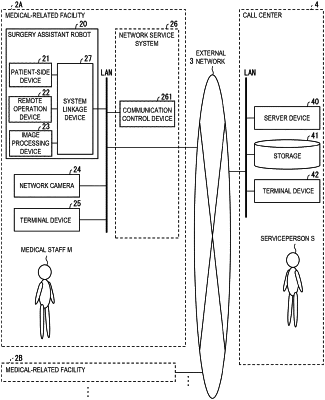| CPC A61B 34/30 (2016.02) [A61B 90/361 (2016.02); B25J 9/1697 (2013.01); G06T 1/0014 (2013.01); G16H 30/40 (2018.01); G16H 40/67 (2018.01); H04N 23/815 (2023.01); G05B 2219/45117 (2013.01); H04N 23/555 (2023.01)] | 21 Claims |

|
1. A remote assistance method for a surgical assistance robot that is provided in a medical facility and comprises a patient-side device to which a medical instrument and an endoscope are attached and a remote operation device configured to remotely operate the medical instrument attached to the patient-side device, the method comprising:
performing, by a communication control device, image processing to visually obscure identifiable information that can identify a person on an image captured by at least one of the endoscope attached to the patient-side device of the surgical assistance robot in the medical facility and a camera that captures an image of a room in which the surgical assistance robot is installed, so as to obtain a processed image;
transmitting the processed image from the communication control device to a server device;
distributing the processed image from the server device to a second terminal device provided in a call center that is different from the medical facility and that does not provide a remote operation apparatus that is configured to remotely control the medical instrument attached to the patient-side device;
transmitting, from the communication control device to the server device, a request for a bi-directional communication that is transmitted from at least one of the surgical assistance robot and a first terminal device used in the medical facility;
establishing, by the server device, based on to the request, the bi-directional communication between (i) the at least one of the surgical assistance robot and the first terminal device in the medical facility and (ii) the second terminal device in the call center; and
displaying, by the second terminal device in the call center, the processed image for a remote assistance for an abnormality occurred to the surgical assistance robot or in the room in which the surgical assistance robot is provided.
|